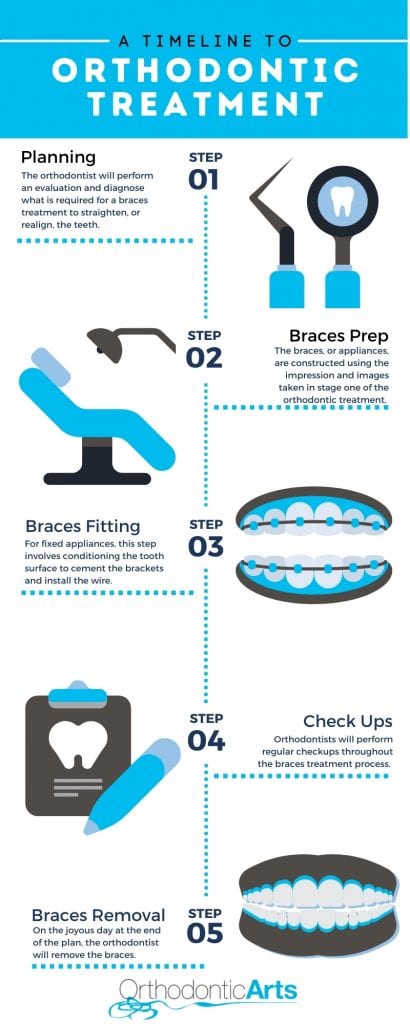Timeline To Orthodontic Treatment
March 16, 2021A Timeline To Orthodontic Treatment
Since the early Greek philosophers and ancient Egyptian pharaohs, humans have searched for ways of straightening teeth. Today, modern orthodontics offer safe and effective treatment for people of all ages who want to have a straight and beautiful smile. The American Association of Orthodontists advises that children have an orthodontic screening by the time they reach their seventh birthday. This is when permanent teeth have begun to develop, and Orthodontists can address problems early.
While the timeline for orthodontic treatment is unique to each patient, most cases are completed in one to three years with checkups every four to 10 weeks. Most orthodontists offer a free consultation where the complete treatment timeline and cost are outlined.
People of all ages receive braces. While most are under 18 years of age, approximately 25 percent of orthodontic patients are adults. The five stages to a braces treatment plan as follows:
 Stage 1) Planning
Stage 1) Planning
During a consultation, the orthodontist will perform an evaluation and diagnose what is required for a braces treatment to straighten, or realign, the teeth. This may take several visits.
First, as medical and dental problems are often related, oral issues are often caused by or can lead to other medical problems. The doctor’s priority is to address any medical problems. Bite impressions, called casting, are taken. This involves having the patient bite down on a mouthguard size tray filled with a soft medium. The tray is removed, and the casting is allowed to dry. The orthodontist will then create a patient’s teeth model to determine the best way to move the teeth into the proper position.
X-rays are taken to see any hidden complications or damage to the mandibular or jaw, joint, and any issues with the roots. Computer-generated images may be made to help the doctor determine the potential success of various treatment options. “Before,” “during,” and “after” photos are taken so the treatment can be more easily tracked.
Stage 2) Braces Preparation
The braces, or appliances, are constructed using the impression and images taken in stage one of the orthodontic treatment. The appliance may be fixed, as in metal braces, or maybe removable, such as an Invisalign system. Fixed braces use what is called an “archwire” with individual dental brackets. Lingual braces are another type of fixed braces but are attached to the inside of the teeth and are much less visible. Removable appliances are designed only to be worn for a few hours each day.
Stage 3) Braces Fitting
For fixed appliances, this step involves conditioning the tooth surface to cement the brackets and install the wire. The teeth are first cleaned, and a priming agent is applied over the teeth before the brackets are installed. Next, after the brackets have been placed, the orthodontist inserts the wire in a way to apply a small amount of force, or leverage, to the teeth to gently coax the teeth into the proper position. For removable appliances, the device will be inserted to check for fit and adjusted, if necessary.
Stage 4) Checkups
Orthodontists will perform regular checkups throughout the braces treatment process. Here, the orthodontist will check to see if the wires’ tension on fixed appliances needs to be adjusted and by how much to keep the right amount of leverage on the teeth. Checkups will be scheduled about every four weeks, and each time the wire will be readjusted as needed. It is essential to keep the appointments, not just to keep the proper tension on the teeth, but so orthodontists can properly clean the teeth and braces of any food debris that may become trapped under the wire and brackets. For removable systems, the process is as easy as moving to the next appliance in the series.
Stage 5) Braces Removal
When the joyous day comes at the end of the treatment plan, the orthodontist will remove the appliance in much the same manner as the wire was removed to make adjustments. For most people, there is no pain when the braces are removed. However, there may be a small amount of soreness from the relief of pressure on the teeth. The soreness is typically short-lived, if present at all, and is easily mitigated with over-the-counter pain medication if needed. However, patients should never try to remove their braces as there is the risk of the metal wire or brackets cutting the gums or lips.
Sometimes referred to as the “retention phase” of the orthodontic treatment, patients must wear retainers after the braces are removed to prevent the teeth from shifting back into their old positions. Retainers can be removed to eat but must be put back in immediately afterward. While typically worn for up to a year after the braces are removed, the orthodontist will determine the exact time frame patients must wear the retainer. Some adults may need to wear a retainer indefinitely.
Orthodontic Arts, your number one Orthodontist in OKC. Our Certified Orthodontist provides the latest and greatest Orthodontic practices to our clients in the OKC and Midtown area. Orthodontic Arts is the best place for child and teen orthodontics as well as adult orthodontics. Be sure to ask about Invisalign and invisible braces! Contact us today at (405) 604-3745 or request an appointment.
